Dive into Wisconsin’s woodlands with our guide to the “9 Woodpeckers in Wisconsin.” Discover the diverse avian species thriving in this region, from the majestic Pileated Woodpecker to the vibrant Red-headed Woodpecker. Explore the beauty of Wisconsin’s forests and their avian inhabitants.
Table of Contents
Types of Woodpeckers in Wisconsin
Downy Woodpecker
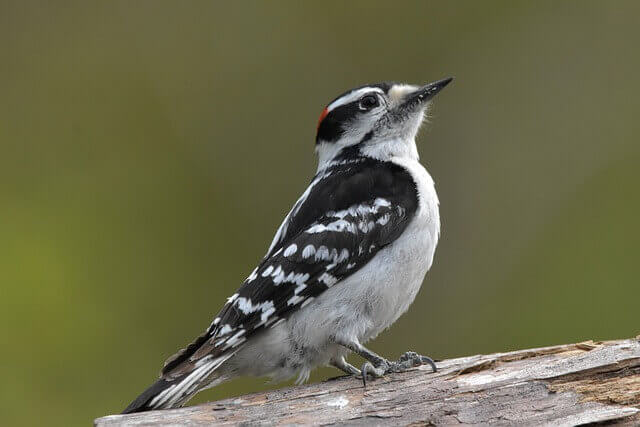
- Length: 5.5-6.7 in (14-17 cm)
- Weight: 0.7-1.0 oz (21-28 g)
- Wingspan: 9.8-11.8 in (25-30 cm).
- Frequency of Occurrence: 34.21% (Statistic by: eBird)
Downy woodpeckers are found in every state in the United States, except for Hawaii. Downy woodpeckers can be found in a variety of habitats, including woodlands, open fields, and even urban areas. They are common throughout Wisconsin, and can be found in a variety of habitats depending on the region of the state.
In northern Wisconsin, downy woodpeckers are often found in coniferous forests. In central Wisconsin, downy woodpeckers are commonly found in deciduous forests.
And in southern Wisconsin, downy woodpeckers are often seen near water sources such as rivers and streams. Downy Woodpeckers feed on a variety of insects, including ants, beetles, caterpillars, and spiders.
They use their strong bills to drill into trees and bark to extract their prey. To attract Downy Woodpeckers to your yard, you can put out a feeding station with suet or peanut butter on a wooden block.
Related Post:
- How to Attract Downy Woodpeckers to Your Yard? (Easy!)
- 7 Birds That Look Like Downy Woodpecker (Explained)
Red-bellied Woodpecker
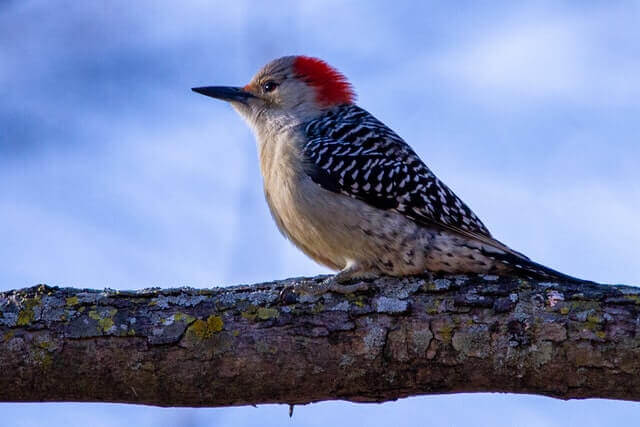
- Length: 9.4 in (24 cm)
- Weight: 2.0-3.2 oz (56-91 g)
- Wingspan: 13.0-16.5 in (33-42 cm)
- Frequency of Occurrence: 27.09%
The Red-bellied Woodpecker is a medium-sized woodpecker found in North America. It ranges from southern Canada to Mexico, and is also found in parts of Central America and the Caribbean.
These birds can be found in most parts of Wisconsin, although they are more common in the northern and central regions.
Red-bellied Woodpeckers live in a variety of habitats, including forests, woodlands, parks, gardens, and even suburban neighborhoods. They primarily eat insects, but also eat fruit and seeds.
To attract Red-bellied Woodpeckers to your yard or garden, you can provide them with a food source such as a suet feeder filled with insects or nuts, or hang a bird feeder that offers a variety of foods. You can also provide them with a water source.
Related Post: How to Attract Red-bellied Woodpeckers to your Yard?
Hairy Woodpecker
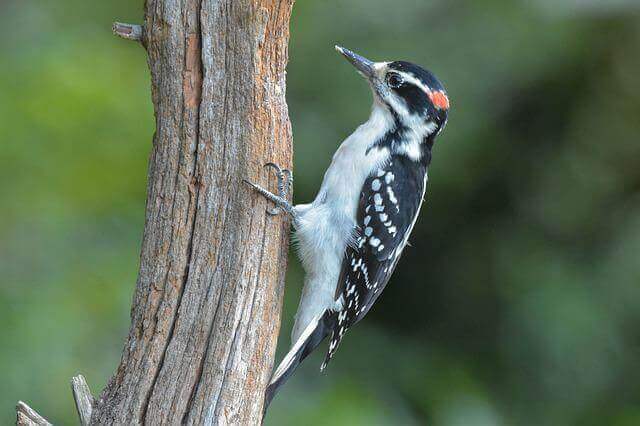
- Length: 7.1-10.2 in (18-26 cm)
- Weight: 1.4-3.4 oz (40-95 g)
- Wingspan: 13.0-16.1 in (33-41 cm)
- Frequency of Occurrence: 19.52%
The Hairy Woodpecker is a bird found statewide throughout Wisconsin, but is more common in the Northwoods area, the Door Peninsula, and in smaller numbers in the southern part of the state.
They live in both rural and urban areas, and can be found in a variety of habitats including woodlands, parks, and gardens. These woodpeckers eat insects, primarily ants and beetles.
They are attracted to areas with mature trees where there is an ample food supply. There are several things you can do to attract Hairy Woodpeckers to your backyard. One is to provide a tall tree for them to nest in.
You can also install a peanut butter suet feeder or even a bird feeder stocked with insects, or place out piles of dead wood for the birds to excavate. Lastly, make sure you have plenty of trees and shrubs for the birds to hide in while they are foraging.
Northern Flicker
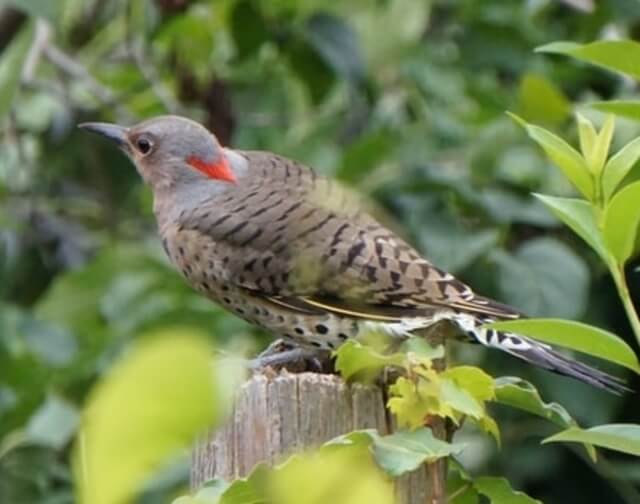
- Length: 11.0-12.2 in (28-31 cm)
- Weight: 3.9-5.6 oz (110-160 g)
- Wingspan: 16.5-20.1 in (42-51 cm).
- Frequency of Occurrence: 14.70%
The Northern Flicker is a medium-sized woodpecker that can be found in Wisconsin. They have a range of habitats, including forests, woodlands, and even urban areas.
Northern Flickers are omnivorous and eat a variety of foods, including insects, seeds, fruit, and nuts. They can often be seen foraging on the ground or in trees.
There are several ways to attract Northern Flickers to your backyard. Providing a food source is essential; they will eat birdseed, suet, or insects that you provide.
You can also create a nesting box for them to use. Finally, make sure there are trees or other structures for them to perch on. Northern Flickers can be found in most parts of Wisconsin. However, they are more common in the northern part of the state.
Related Post: How to Attract Northern Flickers to your Backyard (Easy)
Pileated Woodpecker
- Length: 15.8-19.3 in (40-49 cm)
- Weight: 8.8-12.3 oz (250-350 g)
- Wingspan: 26.0-29.5 in (66-75 cm)
- Frequency of Occurrence: 6.51%
The Pileated Woodpecker is a large woodpecker found in Wisconsin. They have a range that extends from the east to the west coasts of the United States and into southern Canada. In Wisconsin, they are found in most areas of the state.
Some good places to see pileated woodpeckers in Wisconsin are Apostle Islands National Lakeshore, Chequamegon-Nicolet National Forest, and Horicon Marsh State Wildlife Area.
Pileated Woodpeckers live in a variety of habitats including forests, woodlands, and parks. They prefer mature or old-growth forests, but can also be found in areas with smaller trees. They eat a variety of foods, including insects, nuts, fruits, and sap.
To attract Pileated Woodpeckers to your yard or property, you can provide food sources such as suet cakes or insect feeders. You can also place dead trees or logs in your yard to create a nesting habitat for them.
Related Post: How to Attract Pileated Woodpeckers to your Yard (Fast)
Yellow-bellied Sapsucker
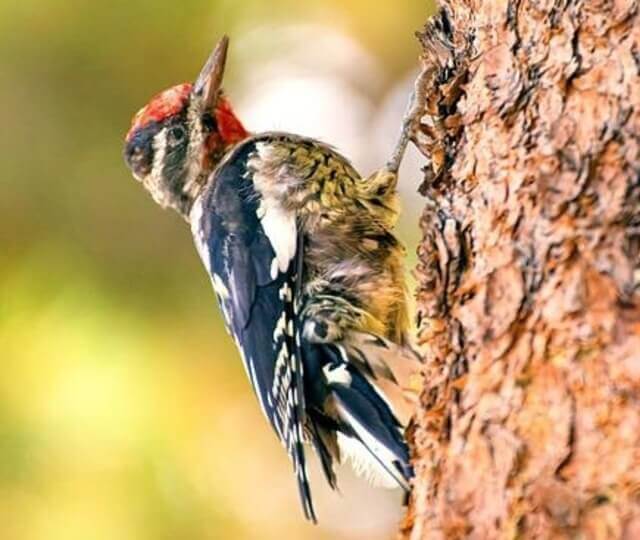
- Length: 7.1-8.7 in (18-22 cm)
- Weight: 1.5-1.9 oz (43-55 g)
- Wingspan: 13.4-15.8 in (34-40 cm)
- Frequency of Occurrence: 4.85%
The yellow-bellied sapsucker is a migratory woodpecker that is found in Wisconsin during the summer months. They range throughout the eastern half of the United States, and into southern Canada.
Yellow-bellied sapsuckers feed on sap and insects. They are attracted to areas where sap is flowing, such as at the base of trees or on utility poles.
They will also forage for insects in open areas, such as meadows or pastures. The yellow-bellied sapsucker can be attracted to backyard birdfeeders by offering suet or black oil sunflower seeds.
You can also plant trees that produce sap (such as maples) near your house to attract these birds. The best places to see yellow-bellied sapsuckers in Wisconsin are along the Mississippi River and in the Northwoods.
Related Post: 16 Interesting Sapsucker Facts Revealed!
Red-headed Woodpecker

- Length: 7.5-9.1 in (19-23 cm)
- Weight: 2.0-3.2 oz (56-91 g)
- Wingspan: 16.5 in (42 cm)
- Frequency of Occurrence: 2.17%
The red-headed woodpecker is mainly found in the eastern half of the United States and in parts of southern Canada. They live in a variety of habitats, including forests, woodlands, parks, and yards.
These birds primarily eat insects, but will also eat fruits and nuts. You can attract red-headed woodpeckers to your yard by putting up a feeder with suet or bird seed.
The best time to observe red-headed woodpeckers is in spring and fall, when they are actively feeding. They like to peck on dead trees and telephone poles to find food.
They are commonly found in the following areas of Wisconsin: Door County, Kettle Moraine State Forest – Lapham Peak Unit, Milwaukee County, and Washington County.
Related Post:
- Birds That Look Like A Red-headed Woodpecker(Explained)
- Interesting Red-Headed Woodpecker Facts (Explained)
Black-backed Woodpecker
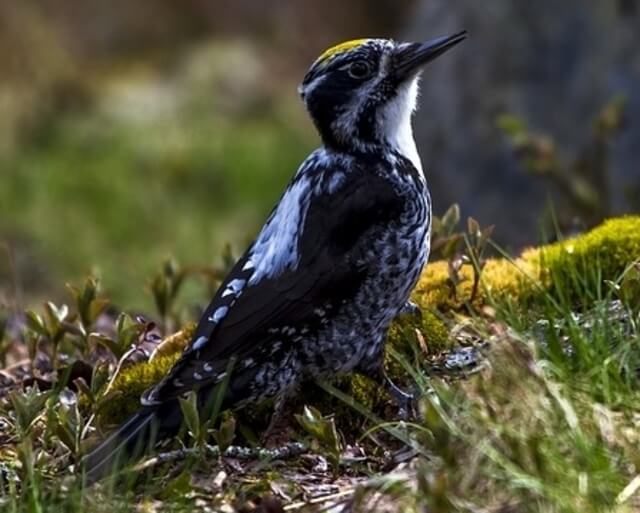
- Length: 9.1 in (23 cm)
- Weight: 2.1-3.1 oz (61-88 g)
- Wingspan: 15.8-16.5 in (40-42 cm)
- Frequency of Occurrence: 0.0161%
The black-backed woodpecker is a medium-sized black and white woodpecker that is found in the forests of North America. This woodpecker has a range that extends from Alaska to Mexico and can be found in a variety of habitats, including coniferous forests, mixed woods, and deciduous forests.
The diet of the black-backed woodpecker consists mostly of insects, but it also eats fruit and nuts. This woodpecker is most commonly found in the northern parts of its range, including Wisconsin.
In Wisconsin, the black-backed woodpecker can be found in the northern part of the state near Lake Superior and in the central part of the state near Madison.
There are several ways to attract these birds to your backyard, including putting up a suet feeder or installing a nest box. Another way is to provide a large dead tree or log for them to nest in and a buffet of insect treats such as grubs, ants, termites, and carpenter bees.
American Three-toed Woodpecker
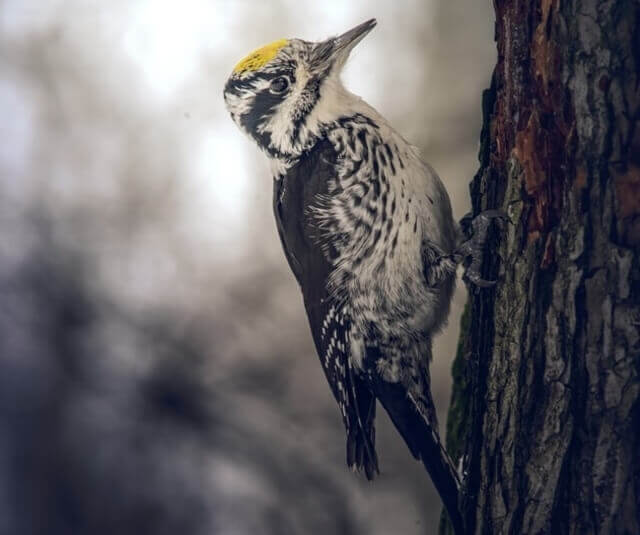
- Length: 8.5-9.0 in (21-23 cm)
- Wingspan: 14.5-15.4 in (37-39 cm)
- Weight: 1.6-2.4 oz (45-68 g)
- Frequency of Occurrence: 0.0007%
The American Three-toed Woodpecker is a medium-sized woodpecker that ranges from Canada to Mexico. They are typically found in the northern part of the state, and can be seen in areas such as Vilas County and Iron County.
They have three toes on each foot, which is how they got their name. These birds use their long bills to peck at trees in search of insects to eat. They are also known for creating cavities in trees where they will nest and raise their young.
They prefer deciduous forests, but can also be found in pine forests and riparian habitats. These woodpeckers feed on insects, larvae, and other invertebrates.
They often forage on the ground or in trees less than 20 feet tall. To attract these woodpeckers to your yard, provide a mix of deciduous and evergreen trees, as well as a dead tree or log for them to forage on.
Related Post: Most Common Backyard Birds In Wisconsin (Explained)




